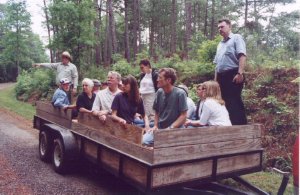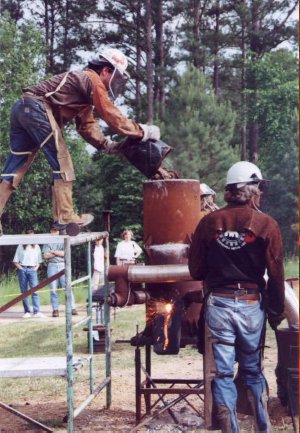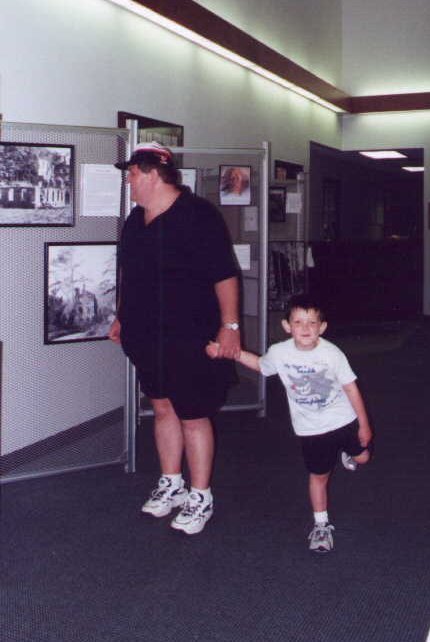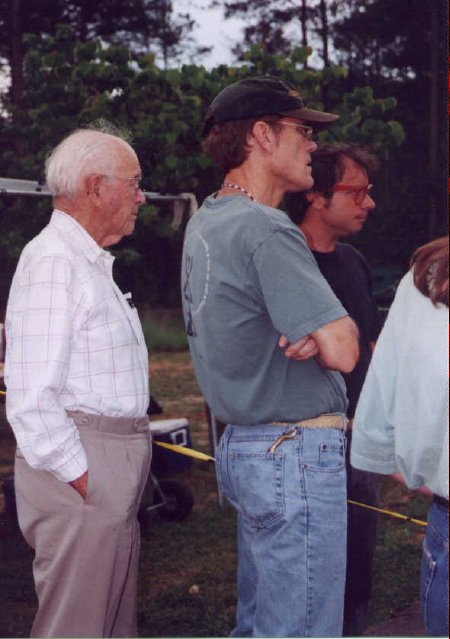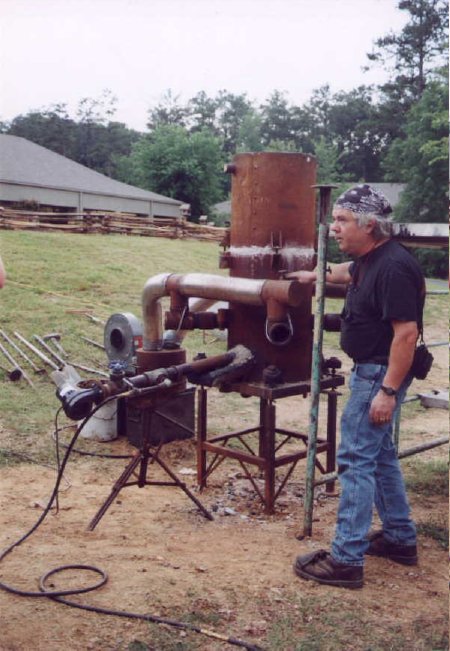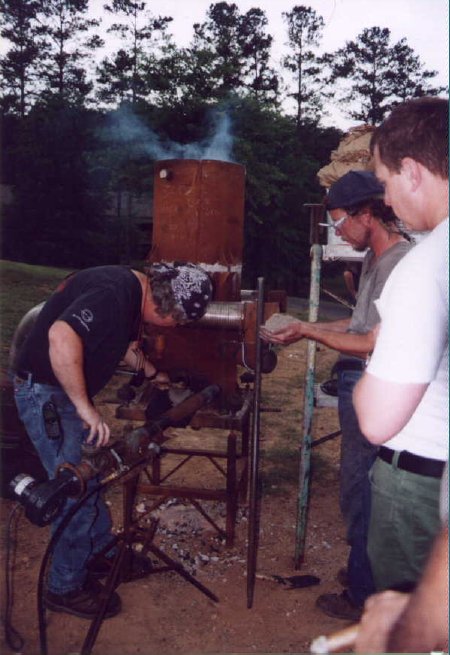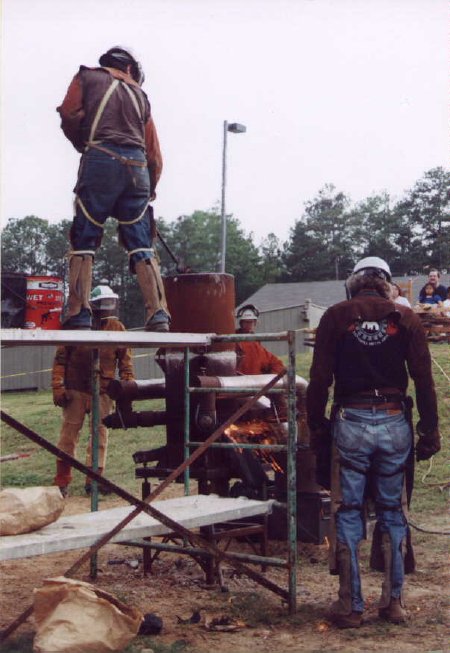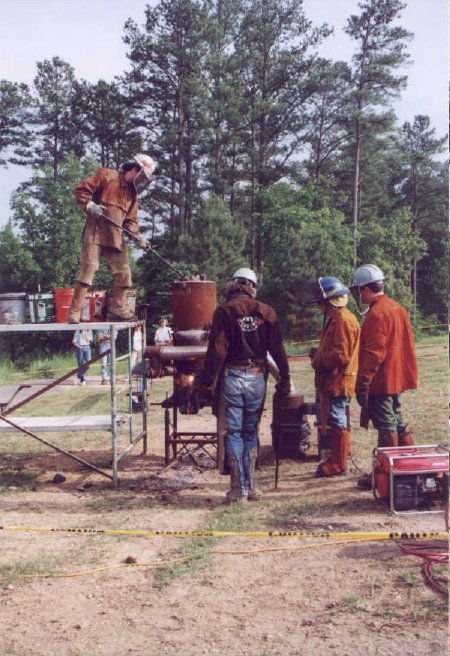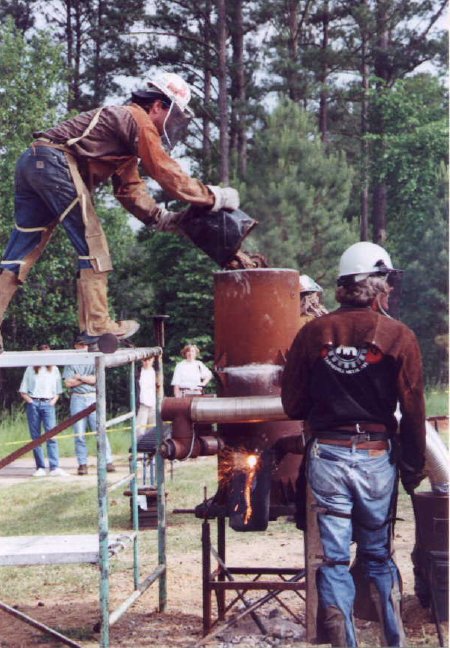The Etowah Valley Historical Society & Red Top Mountain State Park Present Hills of Iron
A Day-Long Event Celebrating the Iron Industry in Bartow County

Red Top Mountain State Park superintendent James Hamilton joined members of Alabama Iron Casting to pour molten iron.
Recently, visitors to Red Top Mountain State Park had the opportunity to see something that hasn’t been seen in public in Bartow County for over a century-iron production. The demonstration was the highlight of “Hills of Iron,” a day-long event celebrating the iron industry in Georgia, sponsored by the Etowah Valley Historical Society and Red Top Mountain State Park.
Participating in the live demonstration was park superintendent James Hamilton, who donned protective attire to join members of Alabama Art Casting as they melted and poured iron for castings.
“This is part of our history, but no one has seen it for a hundred and fifty years” – James Hamilton
“It was great to introduce it back to the county, and a real rush for me.” Those who witnessed the demonstration agreed it was “incredible.” Souvenirs included (warm) cast iron frogs made from a mold fashioned after frogs made at the Tannehill Ironworks in Alabama in the 1850s.
The day began with a photo exhibit at the lodge documenting the history of the iron industry in Bartow County. The attractive display was the result of many hours of work by EVHS members Guy Parmenter, Michael Garland, and David and Chantal Parker. The display also included a table of ore samples collected in Bartow County.
Prior to the Civil War, at least nine iron furnaces operated at one time or another in the county. Today, the remains of five of these furnaces can still be seen along the banks of Stamp Creek and the Etowah River, where the heaviest deposits of iron ore exist.
The industry, which began with the arrival in Bartow County of pioneer furnace builder and ironmaster Jacob Stroup in 1836 and reached its peak in the 1850s, abruptly ended with the physical and economic upheaval caused by the Civil War and the destruction of Mark Cooper‘s Etowah Ironworks. Mining operations continued into the 20th century, but at a declining rate. Today, iron mining is concentrated in the rich ore fields closer to the manufacturing areas of Birmingham, Pennsylvania, and the Great Lakes, where the proximity of furnace and ore cuts down on transportation costs.
“The last furnace built by Jacob Stroup was the Allatoona Furnace, once located where Bethany Bridge now stands at the entrance to Red Top Mountain,” Hamilton said. The bridge crosses what used to be Allatoona Creek. According to Hamilton, “The theory is that the name Allatoona may stem from the Stroups – Jacob and Moses – and not from Native American heritage. Apparently the Stroups’ ancestors had come from the Ruhr Valley in Germany where there is a small town named Altona. Stroup ancestors turn up in Pennsylvania and guess what… there’s an Allatoona, Pennsylvania. They migrate down this way and hmm…. Allatoona Creek, Allatoona Furnace, etc. Is this just coincidence? ” Hamilton poses. “I don’t know. It’s kind of a curious note though.”
Visitors to Hills of Iron also enjoyed a tour of Iron Hill, once a community of miners and the site of extensive mining operations. “This site has not been used much since the mid-1980s when it was used as a campground,” Hamilton said, adding that plans are currently underway to develop the area into a biking trail. The community of Crow Bank at Iron Hill existed until 1923, when mining operations ceased and the population began to dwindle. “It’s a seldom seen part of the park,” Hamilton said, “but it’s important to the history of the iron industry in Bartow County.” Though vegetation covered the once exposed site, visitors got a sense of just how extensive mining was when the tour ended in an open cut mine sixty feet deep.
The event continued in the afternoon when a large crowd gathered at Cooper’s furnace to hear local historian David Archer relate some of the history of Mark Cooper and the town of Etowah, which now rests under Allatoona Lake, just behind the dam. Archer‘s focus was on the financial ups and downs of the Cooper operation, and the difficulties the company had in remaining solvent.
Following Archer, Dr. Nick Honerkamp, director of the Jeffrey L. Brown Institute of Archaeology at the University of Tennessee at Chattanooga and author of Industry and Technology in Antebellum Tennessee: The Archaeology of Bluff Furnace, described the operation of 19th century iron furnaces. Honerkamp‘s detailed description vividly depicted the grueling working conditions of iron production, from the laborers who hammered ore-bearing rocks into manageable pieces, to the “chargers” who loaded ore and fuel into the top of the furnace.
The day-long event concluded with a lecture by James R. Bennett, Alabama Secretary of State and author of Tannehill and the Growth of the Alabama Iron Industry. Bennett was instrumental in developing the 1,500-acre Tannehill Ironworks Historical State Park into one of Alabama’s top ten tourist attractions. The Tannehill tri-furnace ironworks were constructed around 1860 by Moses Stroup, the son of Jacob Stroup.
Moses expanded his father’s ironworks at Etowah and partnered with Mark Cooper to develop the Etowah Manufacturing and Mining Company before migrating to Alabama in 1849, where he constructed three more ironworks.
The Stroups prominence as ironmasters in Bartow County was eclipsed by the success of Cooper‘s operation. “You’re more familiar with Mark Cooper,” Bennett told the audience. “But over in Alabama we’re more familiar with Moses Stroup.” A fourth-generation ironmaster, Moses Stroup was responsible for constructing the largest ironworks in South Carolina prior to his arrival in Bartow County in the early 1840s. From South Carolina to Alabama, the Stroups followed a pattern of developing ironworks where Jacob built the original furnace to supply a local market, and Moses then expanded the operations, usually with the addition of a foundry and rolling mill, to supply a larger, regional market. “Moses Stroup was sixty years in the iron business, and is considered one of the most outstanding and foremost authorities of iron-making in the South,” Bennett said.
From the morning tour of Iron Hill to the huge furnace-shaped cake featured at a dessert reception following Bennett‘s talk, Hills of Iron delighted visitors and proved a great success. “I was very pleased with today’s turnout,” said Red Top interpretive ranger Roy Queen. “I can see this as an annual event.”
Guy Parmenter, president of the Etowah Valley Historical Society, also sees the potential for an annual Hills of Iron celebration. “We were extremely happy to help sponsor this event. It was an incredible opportunity to see a working iron furnace, and we would love to see the program continued,” Parmenter said. “Programs like this help us achieve our mission of educating the public about Bartow County‘s history and heritage.”
“We’ve entered a new era at Red Top,” James Hamilton said of the collaborative effort of the many people involved in developing the Hills of Iron program. “A lot of people spent a lot of time putting this together.
“Much of the credit is given to the Tannehill folks. But we simply could not have done it without the partnership of the Etowah Valley Historical Society, which developed the wonderful exhibit and the publications for the program.” EVHS was also instrumental in obtaining speakers and bringing Alabama Art Casting to Red Top.
Click to see photo gallery:
Return to Preservation >
